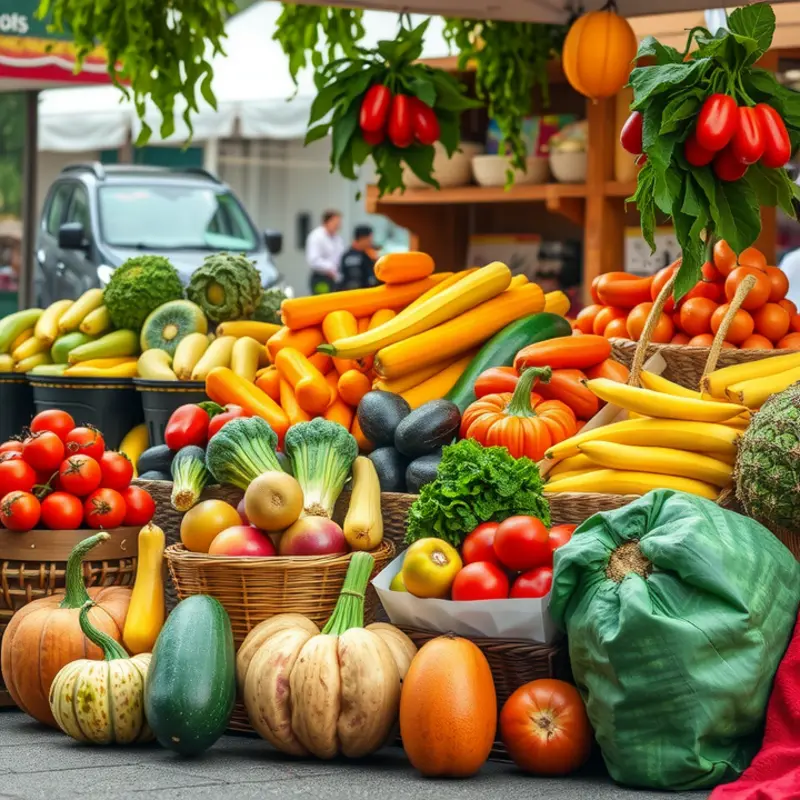Eating is an act that connects us to the Earth and the diverse living ecosystems that sustain us. A biodiverse diet emphasizes consuming a wide variety of foods that promote ecological balance while nourishing our bodies. By incorporating local, seasonal, and sustainable food choices into our meals, we can significantly reduce our environmental impact and support biodiversity. This approach to eating not only contributes to personal health but also fosters a healthier planet for future generations.
The Benefits of a Biodiverse Diet

Opting for a more biodiverse diet offers numerous environmental, health, and cultural benefits. By expanding the variety of species in our diets—both plant and animal—we contribute to creating a sustainable ecosystem. Each species plays a unique role in maintaining ecological balance. Plants aid in preventing soil erosion, enhancing soil fertility, and supporting water retention. When we diversify crop varieties, we’re enriching the environment rather than depleting it. More diverse crops reduce pest and disease pressures, minimizing the need for chemical interventions. This leads to healthier soils and water systems, contributing to overall ecosystem resilience.
On the health front, a diverse diet can improve nutritional intake, providing a broader spectrum of vitamins, minerals, and bioactive compounds. It fosters a robust gut microbiome, crucial for digestion and immunity. Integrating various foods can also lessen the risk of chronic diseases by promoting balance and avoiding the pitfalls of overconsumption of particular elements found in less varied diets. Additionally, using herbs and spices not only enhances flavor but offers health-promoting properties. Check out some functional herbs for mood stability for ideas on incorporating diverse plant-based ingredients into meals.
Culturally, embracing biodiversity in our diets reconnects us with traditional food practices, preserving culinary heritage and promoting regional food economies. This encourages support for local farmers and artisans, fostering economic resilience and cultural preservation. It anchors people to their environment, urging a deeper appreciation for how food is produced and consumed.
Monocultures, or the production of a single crop over large areas, pose severe risks. They lead to soil depletion and increased vulnerability to pests and diseases, demanding heavy use of fertilizers and pesticides. Transitioning toward a biodiverse approach helps mitigate these problems. When consumers choose a range of foods, they’re less reliant on systems contributing to biodiversity loss. By embracing new grains, veggies, and proteins, we actively participate in promoting sustainable agriculture.
Moreover, the choice of a biodiverse diet has implications for our carbon footprint. Diverse cropping systems often require fewer inputs and can be more energy-efficient than intensive monocropping agriculture. These systems improve carbon sequestration in soils and biomass, an essential process in combatting climate change.
By simply choosing to incorporate a broader range of foods, consumers can significantly impact environmental health, nutrient intake, and cultural diversity. This shift requires a conscious effort to explore and celebrate the myriad food options nature provides. Such decisions extend beyond personal benefits, contributing to a more resilient and sustainable global food system.
Practical Steps to Adopt a Biodiverse Diet

Incorporating biodiversity into your diet is a meaningful step towards sustainability and health. Here are some effective ways to start your journey:
-
Explore Local Farmers’ Markets: Discover seasonal produce by visiting farmers’ markets near you. They offer a variety of fresh fruits and vegetables, often unique to the local area. Engage with farmers to learn about lesser-known crops. This not only diversifies your plate but also supports local agriculture.
-
Grow a Backyard Garden: Cultivate a garden at home to enjoy fresh produce and herbs. Select a range of different plants, from leafy greens to root vegetables. For those with limited space, window boxes or vertical gardens can efficiently host a variety of plants. Gardening enhances your connection to food and contributes to dietary biodiversity.
-
Experiment with New Recipes: Expand your culinary repertoire by incorporating less common grains, legumes, and vegetables. Quinoa, amaranth, lentils, and chickpeas are excellent alternatives to more common staples. Try recipes inspired by different cultures to unlock new flavors and textures. This not only adds diversity but can also introduce you to nutrient-rich foods.
-
Reduce Processed Foods: Foods that are minimally processed retain more nutrients and help maintain biodiversity in diets. Prioritize whole foods like whole grains, fresh produce, nuts, and seeds. These options are typically more environmentally friendly due to reduced packaging and processing.
-
Experiment with Flavors and Textures: Use herbs, spices, and alternative cooking methods to bring variety to your meals without relying on salt or artificial ingredients. For ideas on flavor enhancement, check out natural flavor boosters without salt.
-
Participate in Food Swaps: Join local food co-ops or community groups that organize food swaps. This is a way to try different foods without committing to large quantities. Exchanges with community members can introduce you to diverse foods you’ve never considered.
-
Educate Yourself on Eco-friendly Choices: Learn about the environmental impact of food choices. Opt for sustainably sourced ingredients and reduce reliance on products that contribute to deforestation or excessive water use. Choosing environmentally responsible foods supports planetary health and encourages biodiversity.
-
Mindful Eating Practices: Appreciating the flavors and origins of food can enhance your dining experience. Take time to savor each bite, which fosters a greater appreciation for the diverse foods you consume. This approach nurtures a healthy relationship with food and encourages thoughtful consumption.
Adopting these practical steps can gradually enhance the biodiversity of your diet, contributing to a healthier planet and personal well-being. Spark your culinary creativity and embrace the wonderful variety nature has to offer.
Final words
The journey of embracing a biodiverse diet is not just about food; it’s about cultivating a deeper connection with nature and understanding our role within larger systems. As consumers, we have the power to shape agricultural practices and support diverse, sustainable ecosystems through our eating habits. By choosing to incorporate a variety of foods into our diets, we can influence not just our health, but also contribute to the well-being of the planet. Let’s take these steps together towards a more eco-friendly, holistic way of nourishing ourselves and the Earth.








